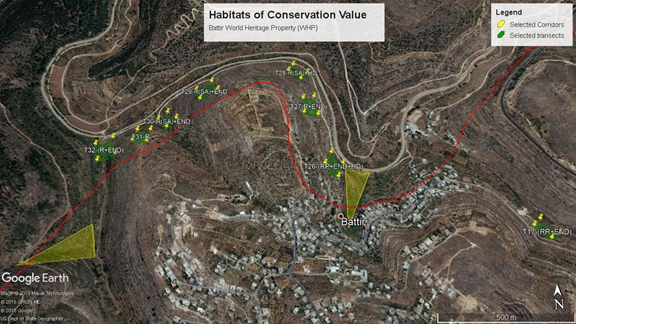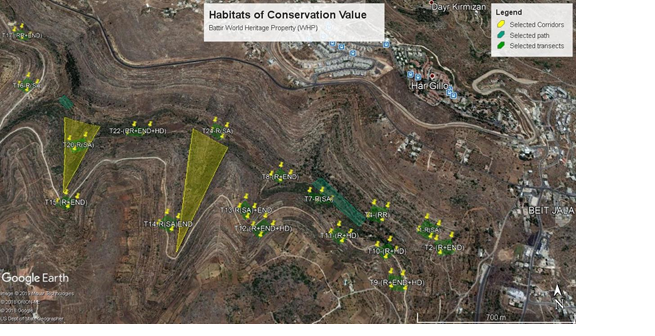Key habitats for Plant biodiversity
The habitats that were found of high conservation value for Plant Biodiversity are diverse, located at different altitudes, and supported with different soil types. The habitats were also selected in accordance to the availability of high diversity of plant species and those that support endemic and rare/very rare plant species.
Habitats of high conservation value by type, physical characteristic and value
|
Habitat |
Transects |
Conservation Value |
Altitude (meters) |
Soil type |
Slope |
|
Mixed oak forest and olive groves |
T2 – Northern Mountainous slope – Beit Jala side |
Rare and endemic plant species |
771-781 |
Rendzina |
Steep |
|
T9 Southern Mountainous slope- Beit Jala side |
Rare, endemic and key stone plant species High plant diversity |
769-770 |
Dark Rendzina |
Steep to moderate steep |
|
|
T10 Southern Mountainous slope- Beit Jala side |
Rare and key stone species High Plant Diversity |
764-769 |
Dark Rendzina |
Very steep (v.steep) |
|
|
T15 Southern Mountainous slope –Mid AL Makhour Valley |
Rare, endemic and key stone plant species |
791-792 |
Dark Rendzina |
Steep |
|
|
T17 Southern Mountainous slope – from Battir side |
Rare, very rare, vulnerable, and endemic plant species |
640 |
Light Rendzina |
V. steep |
|
|
Oak forest and batha association |
T4 Northern Mountainous slope – Beit Jala side |
Rare and very rare species, and key stone plant species |
748-760 |
Rendzina |
Moderate steep |
|
T11 Southern Mountainous slope – Beit Jala side |
Rare and key stone species High plant diversity |
759 |
Dark Rendzina |
V. steep |
|
|
T31 The hill north west Battir Village |
Rare plant species |
565-569 |
Mixed Terra Rossa & Rendzina |
Steep |
|
|
Olive groves and fallow land |
T6 The valley of AL Makhrour- from Beit Jala side |
Rare and key stone plant species |
710-712 |
Brown Rendzina |
Flat |
|
T8 The valley of AL Makhrour- from Beit Jala side |
Rare, endemic species and key stone plant species |
708-712 |
Rendzina |
Flat |
|
|
T32 The cultivated valley behind Battir village – North west Battir |
Rare and endemic plant species |
550 |
Terra Rossa |
Flat |
|
|
T33 The cultivated valley behind Battir village – west Battir |
Endemic plant species |
551 |
Terra Rossa |
Flat |
|
|
Olive groves and batha association |
T13 Southern Mountainous slope – Beit Jala side |
Endemic and key stone plant species |
775 |
Light Rendzina |
Fore Slope – steep |
|
T14 Southern Mountainous slope – Beit Jala side |
Endemic plant species |
784-792 |
Light- brown Rendzina |
Moderate to steep |
|
|
T22 At Al Kulieh Rock – AL Makhrour Valley |
Rare, very rare, vulnerable, and endemic plant species High plant Diversity |
657-659 |
Rendzina |
Flat to Steep |
|
|
T26- The valley and mountain range enclaving Battir Village from the north |
Rare, very rare, and key stone and endemic plant species High plant Diversity |
584-597 |
Terra Rossa |
Steep |
|
|
T27 The valley and mountain range enclaving Battir Village from the north |
Rare, and endemic plant species |
601 |
Mixed Terra Rossa & Rendzina |
Steep |
|
|
Mixed pine and oak forest |
T28 The valley and mountain range enclaving Battir Village from the north |
High Plant Diversity |
584-593 |
Terra Rossa |
Steep |
|
T29 The valley and mountain range enclaving Battir Village from the north |
Endemic and key stone plant species High plant Diversity |
579-586 |
Mixed Terra Rossa & Rendzina |
Steep |
|
|
T30 The valley and mountain range enclaving Battir Village from the north |
Endemic and key stone plant species |
579-582 |
Terra Rossa |
Steep |
|
|
Batha association |
T12 Southern Mountainous slope – Beit Jala side |
Rare, endemic and key stone plant species High plant Diversity |
802-805 |
Light to Brown Rendzina |
Moderate Steep |
|
Paths and corridors |
Corridor Links T14 and T23 |
High Plant Diversity |
|||
|
Corridor Links T15 and T21 |
High Plant Diversity |
||||
|
Path Below T4 and T5 – and trench below T7 |
Rare species and sole species (ex.Orchis galilaea) |
||||
|
Path below T20 and T21 And near E’in A’mdan |
Rare species and sole species (ex.Pyrus communis) |
For rare, endemic and key stone species see section 5.2



